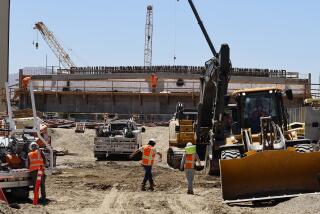State’s Jobless Rate Hits 6.7%, Worst in 4 Years
- Share via
In a new sign that economic woes are spreading in California, the state unemployment rate rose sharply to 6.7% in November from 6% in October, the state Employment Development Department reported Friday. It was the highest level of joblessness in four years.
California’s unemployment rate now is running higher than the U.S. level, reported Friday at 5.9% for November, and seems to be signaling a significant decline in the state’s economic vitality.
“In general, the numbers are terrible,” said David Hensley, a UCLA economist. “We’ve been losing employment for four or five months now.”
Nationally, the November rise in unemployment to 5.9% from 5.7% in October reflected a broad pattern of job losses in construction, manufacturing, retail trade and other industries. The U.S. economy lost 267,000 jobs in November. The drop, added to a decline of 178,000 in October, makes for the worst two-month job loss in eight years, according to the Labor Department.
The California figures are considered more volatile, and a single month’s report does not usually command much attention. But a consistent pattern of deteriorating job statistics has emerged since July, suggesting that the employment picture has darkened.
“You’re definitely seeing a very sharp slowdown in overall growth, and it’s concentrated in manufacturing and construction,” said Jack Kyser, economist at the Los Angeles Area Chamber of Commerce. “I would expect that, in the first half of next year, the unemployment rate will go even higher.”
As recently as June, the California unemployment rate stood at 4.9%, while the U.S. rate was 5.2%. Both rates have risen steadily since then, but the change has been more dramatic in California. By September, California’s unemployment rate had climbed up to 5.9% and surpassed the 5.7% U.S. rate. In October, California’s rate rose once more to 6%, while the U.S. rate stalled at 5.7%; the jump continued in November, and the gap between the state and national figures has grown.
As the state’s unemployment rate has increased, a separate measure of jobs discloses a decline: Since July, California has lost 44,000 jobs on a seasonally adjusted basis, Hensley said. On balance, jobs declined by 2,300 in November, with gains in government and service employment partly offsetting continued losses in construction and manufacturing.
“What’s highly unusual is that we’re in a five-month period of declining employment,” Hensley said. “That is without precedent except in a recession.”
State employment in manufacturing, construction and mining is at lower levels today than it was a year ago, according to preliminary figures from the Employment Development Department. Manufacturing, for instance, has lost 48,000 jobs; the drop in construction totals more than 21,000.
In the last year, economic distress has concentrated far more in New England and the Middle Atlantic region than the West Coast. But layoffs in aerospace, a troubled construction industry and recent declines in real estate suggest that the economic slump is taking a toll in California, as well.
The statistics “tell me that California’s economy seems to be deteriorating more quickly than the national economy,” said Paul Getman, an economist with Regional Financial Associates, in West Chester, Pa. “Probably, the decline has been accelerating in the fourth quarter of this year.”
A close look at state employment data for California shows another sign of weakness: The work force for the month, of 14.6 million people, was 17,000 smaller than the prior month, and 57,000 smaller than November, 1989.
“That tells you some people are leaving the labor force,” Getman said. “They’re discouraged workers.”
The recent weakness in employment is not California’s first such bout. Between July, 1981, and November, 1982, for instance, state payrolls shrank by 284,000 jobs. The state lost 104,000 jobs during a four-month period in the 1980 recession. And it lost 140,000 jobs between November, 1974, and March, 1975.
This November’s jobless rate was the highest since December, 1986, when unemployment also stood at 6.7%.
The question now is whether California is just at the beginning of a serious slide, or whether much of the job loss has already occurred.
Hensley, for instance, worries that the state’s construction industry could lose an additional 100,000 jobs, because of the slowdown in building activity: “There’s nothing for these people to do.”
Jerry Jordan, an economist with First Interstate Bancorp in Los Angeles, noted that California faces tough sledding because of the expected slowdown in defense-related industries and what he believes will be a two-to-five year correction in commercial real estate.
“Construction employment in California is going to fall for two more years--and there’s been so much high-rise overbuilding in Southern California that we won’t need any new office space for five to 10 years,” Jordan said.
Staff writer Oswald Johnston in Washington contributed to this story.
More to Read
Inside the business of entertainment
The Wide Shot brings you news, analysis and insights on everything from streaming wars to production — and what it all means for the future.
You may occasionally receive promotional content from the Los Angeles Times.










